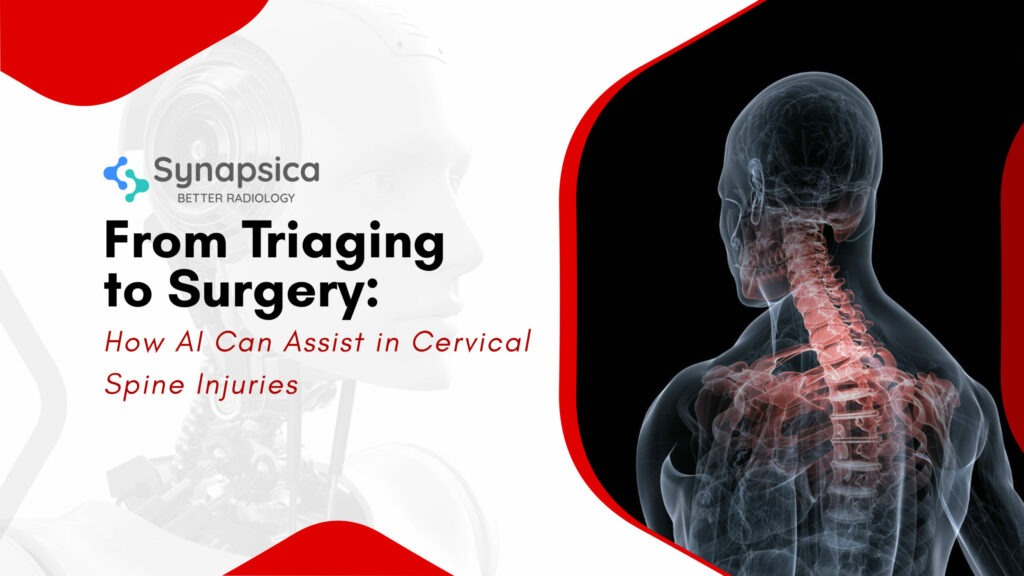
AI is becoming the new normal in the healthcare industry. The breakthrough technology that was widely used in patient-facing applications and cancer diagnosis until a few years back is now assisting healthcare professionals in treating cervical spine injuries. Evidently, AI is becoming an integral part of medical imaging, particularly spine radiology.
The cervical spine, which is the first 7 of the 33 vertebrae, acts as a sheath to the spinal cord and is highly prone to injuries because of its anatomy and flexibility. One-third of the cervical spine injuries occur in C2, and the major contributors to cervical spine injuries are:
- Motor vehicle accidents (42% to 56%)
- Falls (19% to 30%)
- Sports activities (6% to 7%)
According to a study, the US records nearly 12,000 new cervical spine injury cases every year 42% of which are due to vehicle crashes. Cervical spine injuries are more critical as compared to the other spine injuries as they are life-threatening, if not causing paralysis down the neck – which means the person is likely to stay immobile and bedridden for the rest of his/her life.
How AI can assist in cervical spine injuries
AI is exhibiting promising potential in healthcare, particularly in medical imaging. Besides cancer diagnosis and drug discovery, AI is finding value in diagnosing and treating spine problems, which is one of the leading causes of disability worldwide. Here’s how AI will improve cervical spine treatment:
1. Triaging of cervical spine injuries
Triaging is one of the crucial aspects of healthcare delivery although it is perceived as a menial task. In the case of cervical spine injuries, triaging is paramount for the timely delivery of patient care, particularly in the emergency department. AI can help in quick reading of patient scans and flag all the deformities within seconds, which might take more time when done manually.
Also, chances of missing out on minute details are high when radiologists tend to read images quickly, which might lead to incorrect diagnosis and treatment. Missing out on minute details might also lead to new problems in the long run.
AI can not only facilitate quick and thorough reading of patient images but can also dramatically reduce the turnaround time.
2. Early diagnosis of cervical spine problems
Neck pain is becoming a social problem as much as it is a personal problem, affecting nearly 30% to 50% of the adult population worldwide in any given year.
While poor postures, muscle strain, trauma, and repetitive movements are the common reasons for neck pain, there are also other underlying reasons like cervical degenerative disc disease, cervical stenosis, cervical spondylosis, cervical herniated disc, etc., that can also cause neck pain.
Cervical problems are diagnosed based on the degree and duration of neck pain a person experiences. Neck pain duration is classified into the following categories:
* Acute: pain that lasts less than four weeks
* Subacute: pain that lasts for 4 to 12 weeks
* Chronic: pain that lasts for 3 or more months
But not every cervical problem exhibit symptoms. For instance, conditions like a slipped disc don’t always cause symptoms whereas cervical spondylosis rarely causes pain on its own. This means a person can very well have a slipped disc in his/her cervical region but experience acute pain, which can mislead the physician to think that the pain is just the result of poor posture.
Even if the physician orders an imaging test to rule out the possibilities of degenerative diseases, there are chances of missing out on other conditions like neural foraminal stenosis as they are not the point of suspicion or concern.
AI can help in measuring elements of the cervical spine. Comparing AI’s measurements against the anatomical and physiological values will help radiologists and physicians to diagnose cervical spine problems at an early stage, even the asymptomatic ones.
3. Improve the clinical value of reports for better surgical decisions
Have you heard about surgeons going for patient scans directly instead of reading their radiology reports?
A lot of surgeons feel that it is better to go directly for patient scans rather than reading radiology reports first because they feel that these reports lack the clinical value requisite for surgeons.
Clinical value in reports is paramount as it helps the physician/surgeon to choose the right course of action. Subjective reporting not only reduces clinical value in reports and leads to delayed diagnosis, it can also create new problems due to incorrect treatment.
The harmful effects of subjective reporting can be prevented through objective reporting, which is recording the measurements for the various cervical spine elements. Objective reports improve the clinical value of reports as well as enable physicians and surgeons to make the right decisions.
But objective reporting is time-consuming and might also increase the workload of radiologists and lead to delayed reporting. With the help of AI, objective reports can be quickly generated, enabling physicians to provide the right treatment at the right time.
AI in spine care – what the future holds?
AI is improving day by day. Vaccines and drugs that took years to be discovered can now be synthesized within days or hours with the help of AI.
In spine care, AI will enable timely treatment and improve patient outcomes, not just for cervical spine injuries, but also for the injuries in thoracic and lumbar regions. By facilitating quantitative imaging analysis and objective reporting, AI will help in reducing, if not eliminating misinterpretations and misdiagnosis of spine problems.
Intrigued by AI’s potential in radiology and spine care, numerous health tech firms are building AI algorithms that will automate radiology reporting. One such algorithm is, Spindle – an AI reporting assistant for spine MRIs that can automate spine reading and reduce up to 70% of radiologists’ time spent on reporting for spine MRIs by generating objective reports in just one click!
Intrigued? Check out how Spindle simplifies MRI spine reading. Click on the image below





